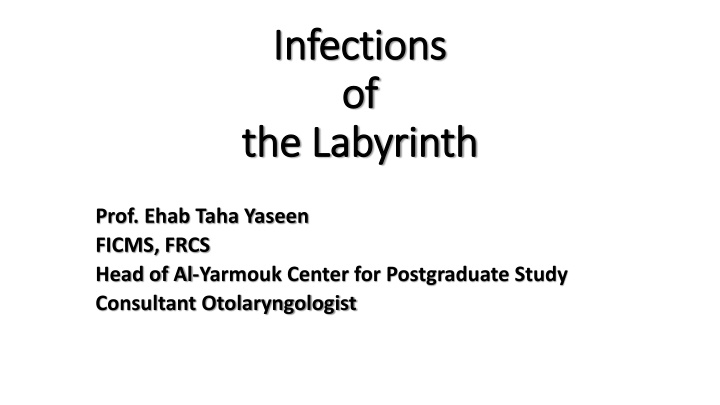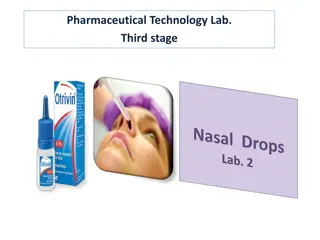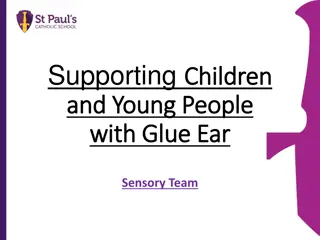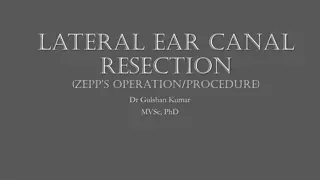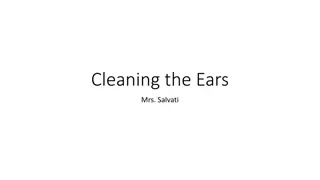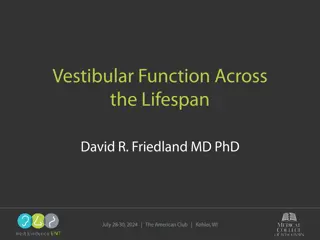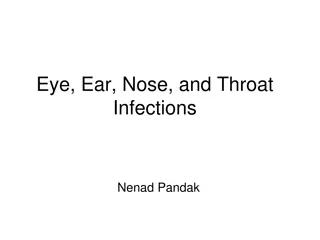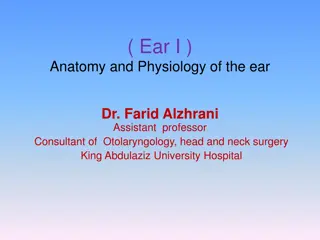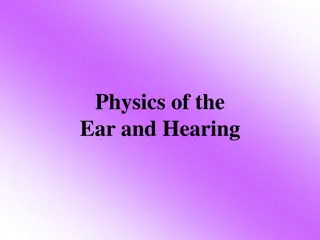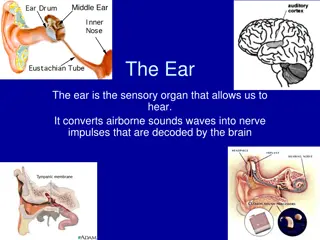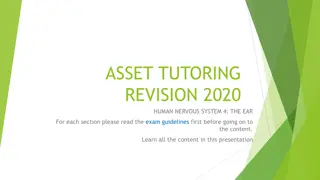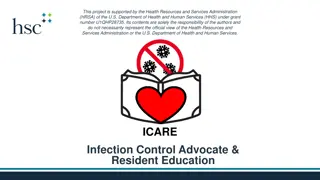Inner Ear Infections & Labyrinthitis
Infections of the labyrinth can lead to hearing loss and other inner ear pathologies caused by viruses, bacteria, and fungi. Learn about prevention methods, diagnostic approaches, and the impact of congenital CMV infection on hearing health.
Download Presentation

Please find below an Image/Link to download the presentation.
The content on the website is provided AS IS for your information and personal use only. It may not be sold, licensed, or shared on other websites without obtaining consent from the author.If you encounter any issues during the download, it is possible that the publisher has removed the file from their server.
You are allowed to download the files provided on this website for personal or commercial use, subject to the condition that they are used lawfully. All files are the property of their respective owners.
The content on the website is provided AS IS for your information and personal use only. It may not be sold, licensed, or shared on other websites without obtaining consent from the author.
E N D
Presentation Transcript
Infections Infections of of the Labyrinth the Labyrinth Prof. Ehab Taha Yaseen FICMS, FRCS Head of Al-Yarmouk Center for Postgraduate Study Consultant Otolaryngologist
Introduction Introduction - RNA and DNA viruses, bacteria, and fungi cause infections of the human labyrinth in fetuses, children, and adults. - Selective vulnerability of inner ear structures varies by the virus, and results in different inner ear pathologies. - Some viruses and bacteria primarily destroy sensorineural epithelium causing permanent hearing loss, whereas other viruses, such as cytomegalovirus, cause little direct damage to cochlear sensorineural structures, and apparently cause deafness by another mechanism. - The precise role viral infections play in sudden sensorineural hearing loss, vestibular neuritis, and Meniere's disease is unclear. - There is increasing evidence that hearing loss from otosclerosis is associated with a persistent rubeola virus infection of the stapes footplate
- Administration of mumps, rubella, rubeola, and varicella-zoster vaccines is the best method to prevent viral inner ear infections. - Placement of cochlear implants is successful treatment for children born with congenital deafness from cytomegalovirus or rubella.
Types of Labyrinthitis Types of Labyrinthitis 1) Congenital SNHL 1. CMV 2. Rubella 2) Acquired SNHL 1. Sudden SNHL 2. Mumps 3. Measles 4. Varicella Zoster 5. Herpes simplex 6. Bacterial and Fungal 7. Syphilis (congenital and acquired) 8. HL in immunocompromised
Congenital CMV infection Congenital CMV infection - CMV is the most common infectious cause of congenital hearing loss in the United States - The incidence 0.3 to 1 case/100 live births. - Less than 5% of all congenital CMV infections result in the severe infection termed cytomegalic inclusion disease. In this multiorgan infection, the incidence of SNHL is 50% in infants who survive the neonatal period. - Hearing loss when measured years later is bilateral, symmetric, and often severe. - High-frequency hearing loss is usually greater than lower frequency hearing loss. - Most (>95%) congenital CMV infections are silent
Diagnosis - History is unreliable (most maternal infections are asymptomatic) - CMV from fresh urine during the first 1 to 2 weeks of life. - PCR (CMV DNA) from urine, blood, CSF, and infected tissues. - IgM (in 60% to 75% infected) in umbilical cord or infant serum. Maternal IgM antibody normally does not cross the placenta. - CMV has been isolated from the amniotic fluid of mothers with a congenitally infected fetus. - After 1 year of age, diagnosis of congenital CMV infection is very difficult. - Healthy infants may acquire the virus infection asymptomatically, shedding the virus in their urine and developing antibody titers.
Management and Prevention Four approaches are adopted and includes: 1) Prevention of primary CMV infection: vaccines have been developed and are in clinical testing. 2) Treatment of pregnant women with primary CMV infection has been tried by passive immunization using hyperimmune CMV gamma globulin. 3) Valacyclovir at 8 g/day given to pregnant women with primary CMV infection has been shown to achieve therapeutic levels in maternal and fetal blood with a reduction in fetal viral load. The antiviral drugs, ganciclovir and valganciclovir, have had some success in treating infants with cytomegalic inclusion disease. 4) Cochlear implants.
Congenital Rubella Deafness Congenital Rubella Deafness - Rubella vaccine, yield dramatic decrease in the number of cases in developed countries. - The WHO estimates that more than 100,000 infants are born each year with congenital rubella syndrome with 50% having hearing impairment. - In many developed countries, it is estimated that 15% to 20% of women in childbearing years are susceptible to rubella infection, a number that is similar to that in industrialized countries in the pre-vaccination era.
- Infection during the first trimester of pregnancy: places the fetus at the highest risk of congenital infection and subsequent hearing loss. In addition to the hearing loss, infants are often born with cardiac malformations, vision loss, and mental retardation. Approximately 50% of infants born with symptomatic congenital rubella have hearing loss. - Infection during the second and third trimesters: Often are born with silent rubella infection and appear healthy at birth. 10 to 20% of these children are subsequently identified as hearing impaired. HL usually bilateral often asymmetrical.
Diagnosis (1) Isolation of rubella or detection of rubella-specific RNA from urine or throat cultures during the first weeks of life, (2) Serum IgM antibodies against rubella (3) Increased antibody titer to rubella in an infant during the first few months of life who did not receive the rubella vaccine. - In children older than 1-year, congenital rubella is difficult to diagnose because many children have received the rubella vaccine. A maternal history of rash during pregnancy is unreliable for establishing or ruling out the diagnosis. Congenital rubella has been diagnosed in utero by isolation of rubella from amniotic fluid. No specific management for children exists because no antirubella virus drugs are available. Management should be directed toward minimizing the consequences of the hearing loss and possible use of a cochlear implant.
Mumps Deafness Mumps Deafness - Deafness associated with mumps usually develops in children toward the end of the parotitis, but can occur from a subclinical infection in the absence of parotitis. - The onset of HL is usually rapid and unilateral in 80%. - HL is maximal at high frequencies. - HL often is profound. - Tinnitus and fullness are common. - In two patients with acute mumps deafness, MRI showed enhancement of the labyrinth and CN VIII and the cochlea and vestibule.
Diagnosis 1) Isolation of mumps virus from the saliva or CSF, or detection of mumps virus RNA 2) Fourfold or greater serologic increase in mumps antibodies between acute and convalescent serum samples. 3) Sensitive real-time reverse transcriptase PCR assays are available for rapid detection of mumps virus from saliva. - Currently, no specific antiviral drugs for mumps deafness exists, and it is unclear whether administration of corticosteroids improves hearing recovery. - Administration of mumps vaccine in infancy effectively prevents subsequent mumps infections in childhood and adulthood
Measles Measles Rubeola virus. The incidence of deafness in all acquired deafness < 1/1000, was 3%-10% before vaccine. Typically, bilateral asymmetrical high frequency SNHL at time of rash, may be unilateral The HL acutely may be with vertigo and tinnitus and loss of calroic response in one or both ears. May be CD due to otosclerosis. Diagnosis: 1) Isolation from throat cultures 2) Detection of rubeola viral RNA from clinical specimens 3) Identification of rubeola viral Ag by immunofluorescent staining of exfoliated epithelial cells obtained by swabbing of the pharynx, conjunctiva, or buccal cavity 4) Demonstration of a fourfold or greater serologic increase in measles antibody titer between acute and convalescent serum samples. At present no antiviral medication has shown benefit in the treatment of deafness from measles. It is unclear whether administration of steroids is beneficia
Varicella Varicella- -Zoster Virus Deafness and Vertigo Zoster Virus Deafness and Vertigo - Ramsay Hunt syndrome, is caused by a VZV infection that became latent in the geniculate ganglia during the period of acute chickenpox. - Decades later, the VZV breaks latency and replicates first in the geniculate ganglion and then travels down the peripheral facial nerve, causing a peripheral facial palsy that resembles Bell's palsy. - Approximately 25% of patients experience vestibular or cochlear symptoms (or both) apparently caused by spread of inflammatory cells from the geniculate ganglion to the inner ear, spiral, and vestibular ganglia. - Occasionally, patients develop prominent vertigo or hearing loss before or along with the facial palsy that may be mild.
- Vesicles, which may be painful, usually develop on the skin of the pinna of the ear, behind the pinna, and along the external auditory canal. - 1 to 2 days later -> unilateral facial paralysis and deep ear pain. The facial weakness usually improves over weeks but is occasionally permanent. - 1/4 have has vertigo, nystagmus, tinnitus, and hearing loss. - SNHL occurs in only approximately 6% of patients. - Audiograms vary, may suggest primary cochlear involvement or cochlear nerve damage. - Caloric tests often show decreased to absent responses in the involved ear.
Diagnosis - Clinical. - MRI with contrast of the temporal bone show enhancement of the involved geniculate ganglion and facial nerve. - PCR: detection of VZV DNA in vesicle fluid, facial nerve sheath, or CSF - Histologic presence of multinucleated giant cells in vesicle scrapings. Management - Acute treatment with high-dose acyclovir (800 mg PO five times daily for 7 days) - Or Famciclovir (500 mg PO three times daily for 7 days). - Or Valaciclovir (1 g PO three times daily for 7 days) - Plus, a tapering 6-day course of prednisone (beginning usually at 1 mg/kg PO) is widely administered for herpes zoster oticus. - Steroids and acyclovir better prescribed early.
- The HL, vertigo, and facial weakness slowly improve over weeks to several months. - Complete hearing recovery in 66% of children and 38% of adults. - Some patients have permanently reduced caloric responses. - A new adult varicella vaccine (Zostavax) has been approved by the FDA
Herpes Simplex Virus Deafness Herpes Simplex Virus Deafness - Infants surviving HSV encephalitis may have permanent hearing loss. - Even infants surviving the milder HSV infection of skin occasionally have subsequent hearing loss. - An adult with HSV encephalitis has also been reported to have severe bilateral SNHL. - There is also evidence against HSV as a cause of sudden hearing loss. HSV has not been isolated from perilymphatic fluid or inner ear tissues, and Cowdry type A inclusion bodies (typical for HSV infection) have not been identified in inner ear tissue.
Sudden SNHL Sudden SNHL - Loss of greater than 30 dB in three contiguous frequencies that occurs in less than 3 days in the absence of a skull fracture. - Most patients awaken with the hearing loss, or the loss develops within minutes to several hours. - 90% unilateral. - 50 % accompanying vertigo or imbalance. - Recovery from 45% to 60%. - The usual recovery period is days to weeks. After 1-month, little recovery occurs. - The extent of recovery is related to age and severity of initial hearing loss. - Untreated patients younger than 40 years of age have a better recovery rate. For individuals older than 40 years, the recovery rate may be only 30%.
Bacterial and Fungal Labyrinthitis Bacterial and Fungal Labyrinthitis - Bacteria and fungi can damage the peripheral auditory and vestibular systems through 1) Round window or modiolus: toxins or inflammatory cell cytokines that reach the perilymph. 2) Purulent exudate enveloping CN VIII with nerve infarction or entrapment 3) Purulent exudate or infectious agent reaching the cochlear perilymphatic space by way of the cochlear aqueduct from an infected CSF subarachnoid space 4) Ototoxic antibiotics to manage infection with elevated concentrations in blood.
Other causes of Labyrinthitis Other causes of Labyrinthitis Self Learning - Bacterial and Fungal Meningitis. - Congenital and Acquired Syphilitic Deafness. - Hearing Loss in Immunocompromised Patients.
